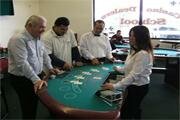Featured Casino
Sun Palace Casino


Blackjack Strategies
Visit Las Vegas USA Casino

Play Online Blackjack, Poker, Slots and many other online casino games!
Blackjack Articles
Featured Casinos
Vegas Casino Online
Sun Palace Casino
Slots Plus .com
Search articles online
General Gambling Articles
Best BlackJack Game
How Big To Bet
D'Alembert System
Summary on D'Alembert System

Play Blackjack,
Free Card Games
and more at
Vegas Online Casino
How Big To Bet
D'Alembert System
Summary on D'Alembert System

Play Blackjack,
Free Card Games
and more at
Vegas Online Casino
Gambling Links
Seing Cards Faster |
<< Back | ||||||
Peter Giles says: I enrolled in dealer's school to see what I could learn to aid my game. I found that many break-ins are very nervous and overanxious. I discovered a new trick for this kind of dealer.
If you move your cards forward as though you were getting ready to scratch for a hit, they will often start sliding the top card forward in anticipation. As most schools teach their students to tilt the deck back (so card-markers cannot see the marks), it is often easy to get a peek at the top card. A little training with a tachistoscope and nothing can slip by you — burn cards, bottomcards, hole cards, top cards — if it is flashed before your eyes, no matter how quickly, you can pick it up.
As a tachistoscope is primarily an educational tool, it can be obtained at educational supply houses. It is a fairly simple instrument — basically a slide projector with a timing device, accompanied by a screen. When I started using a tachistoscope, I knew Utile more about blackjack than that it existed. This was somewhere in the mid-sixties. I was on a mission of conquest, as usual, and the enemy was myopia. I had heard that Aldous Huxley had become nearly blind — he could read the large E on the standard eye chart at three feet — and had acquired 20-20 vision by the use of some very simple drills designed to relax and make proper use of the involuntary muscles in the eyes. Somewhere in the mid twenties a man by the name of William Bates decided that modern optics was on the wrong track. He came to the conclusion that almost all visual problems were psychological in nature, and he spent most of his life proving it. Huxley contacted his chief disciple, a woman by the name of Margaret D. Corbett. With her help, he corrected his vision. My vision was not that bad, but I was very interested in the prospect of throwing away my glasses. I read Huxley's book on the subject, The Art of Seeing, and came to understand why I was near-sighted. The book is an excellent work on the relationship of vision to psychology, and anyone who wants to correct his vision should read it. Unfortunately, the book does not really tell you how to do it. So I picked up Corbett's Help Yourself to Better Sight. With this book and my tachistoscope as aids, I managed to function quite well without glasses in about three months. However, more time was necessary to make the changes permanent. As the drills were very tedious and time-consuming, I relaxed my discipline and in a few months had to resort to wearing glasses again. If you want the effects to be permanent, you must continue with the exercises that brought them about for about another year or two. I got bored.
Getting back to blackjack, a player with glasses cansee just as well as a player with normal vision. Their mutual apparatus is about equal. But there was a side benefit to using the tachistoscope. Even though I settled for glasses, I found that I could still pick up an image with enormous speed. I manage to see my share of hole cards. The distinction to be made is between accuracy and quickness. A tachistoscope will not help you to see better; it will help you to see faster. It does not matter whether or not you wear glasses. As the cost should not be high, the only question is whether or not it is worth the time. For a professional who plays a lot, wants to round out his game, and take advantage of every opportunity, I highly recommend its use. Many counters use flash cards to help learn strategy variations. It would be possible to make up a set of tachistoscope cards to flash on the screen. However, the present material, which usually consists of words and phrases, suffices. If you can improve your speed in picking up a word or phrase, you will find that you can pick up other things faster too. You are developing a technique that is general to use in specific circumstances. It does not really matter what you flash on the screen. If you can pick up words in l/250th of a second that you could see before in 1 /10 of a second, you will find that this ability carries over to any object you happen to be viewing during the course of everyday life. All you have to do is keep moving the timing device a little each day (or week). When you conquer one speed, move on to the next. All you have to do is look at the screen. Do not try to get faster. Rely on time. If you try, it will slow you down. You are trying to make an improvement in an involuntary mechanism, and at best, any voluntary action on your part will get you nowhere. Keep your timer set at a speed just above your capacity at the moment, always forcing the involuntary mechanisms to perform just a little bit better. Do not try to make rapid jumps overnight. Be patient. In a week or two you will see some improvement. In a month or two you will be patting yourself on the back. Sooner or later you will start seeing subliminal flashes at the movies telling you how much you love popcorn. You will be able to watch the cocktail waitress and still pick up the burn card in your periphery. When you are satisfied with yourself, keep watching the screen for a little each day. The longer you watch it, the less you will lose when you stop watching it. An eye doctor says: I have some information on what Peter Giles is talking about. I am an eye doctor and I specialize in visual therapy, which includes reducing nearsightedness and improving people's perceptual skills and abilities. Two other doctors and I did a visual scan on the Atlanta Braves baseball team, checking all of their skills. We also work with some professional football teams. We use tachisto-scopic exposure in tiaining them to see quickly and accurately and take in a whole picture all at once. So I am quite familiar with tachistoscopes. I have designed some visual therapy instruments. Here is a technique for learning to catch glimpses of cards using a deck of cards instead of a tachistoscope. Take one card and without looking at it, turn it over and place it in the middle of the deck. Hold the deck design side up. Riffle through looking at the upper left hand corners. You can either slow down or speed up the riffling of the cards to suit your own particular skills. You can get where you can expose that one face-up card for just a fraction of a second and catch it. Sometimes you can even getit subliminally. For example, if you riffle through and you think you may or may not have seen the card, just make a note of the first card that comes into your mind. Then riffle through again but slower and see if the card you noted is not the card that is face up. You only saw it fleetingly and it registered on the subconscious rather than on the conscious mind.
© Copyright 2006 Online Blackjack News. It may not be published, broadcasted, rewritten, or redistributed.
|
|||||||






 Trackback URL |
Trackback URL |
 0 Comments
0 Comments